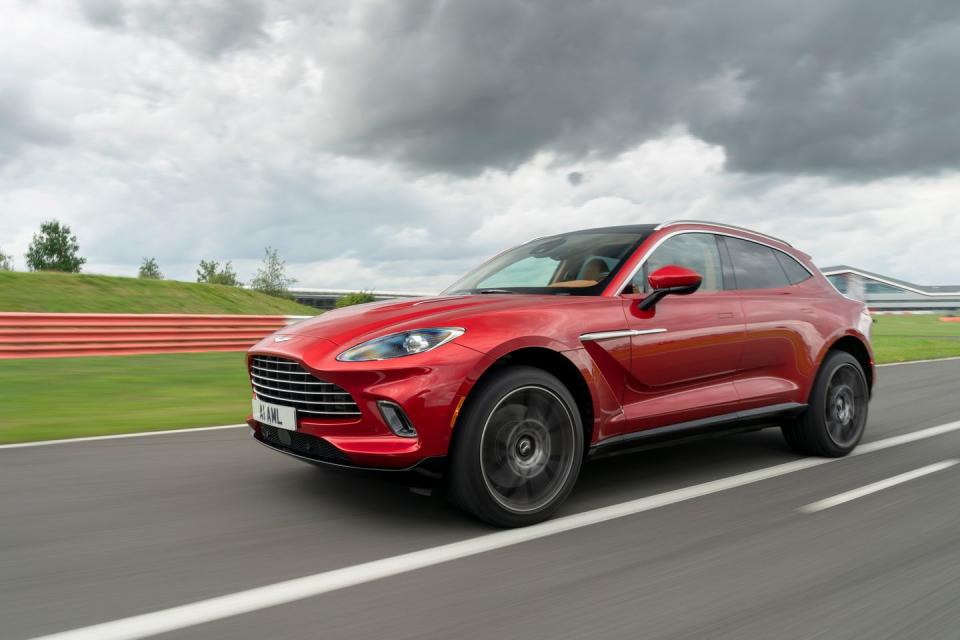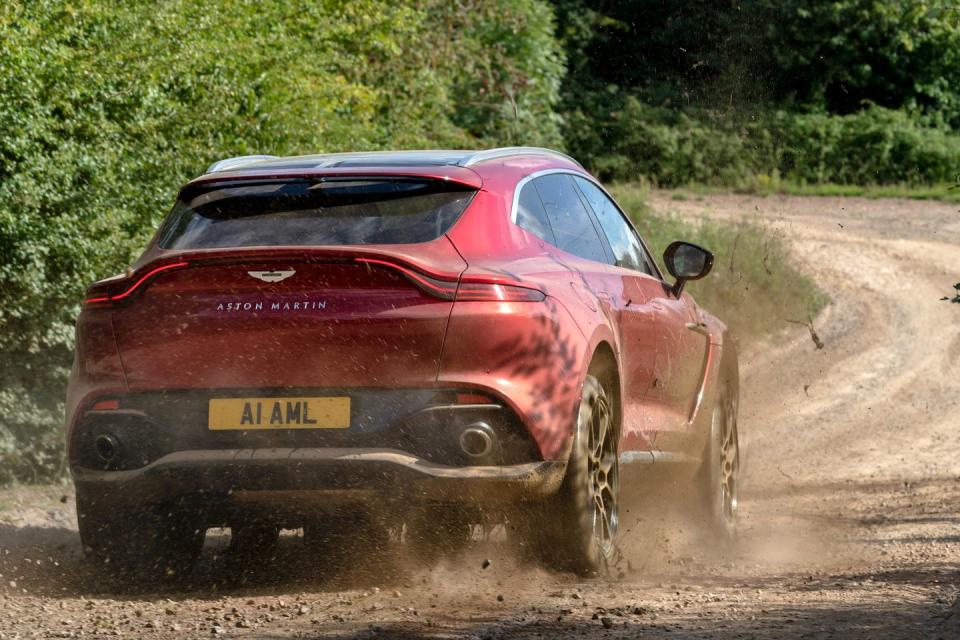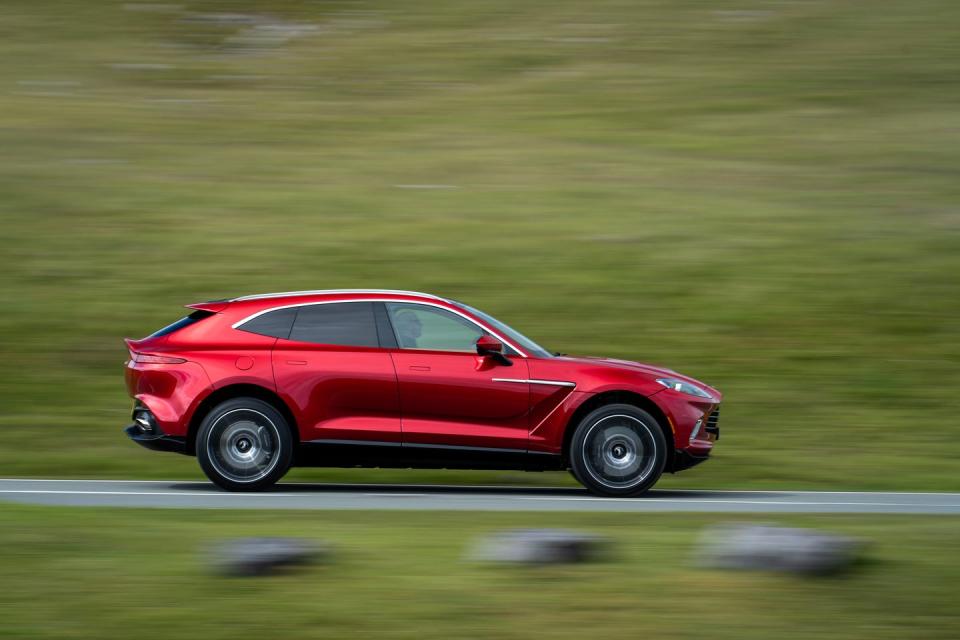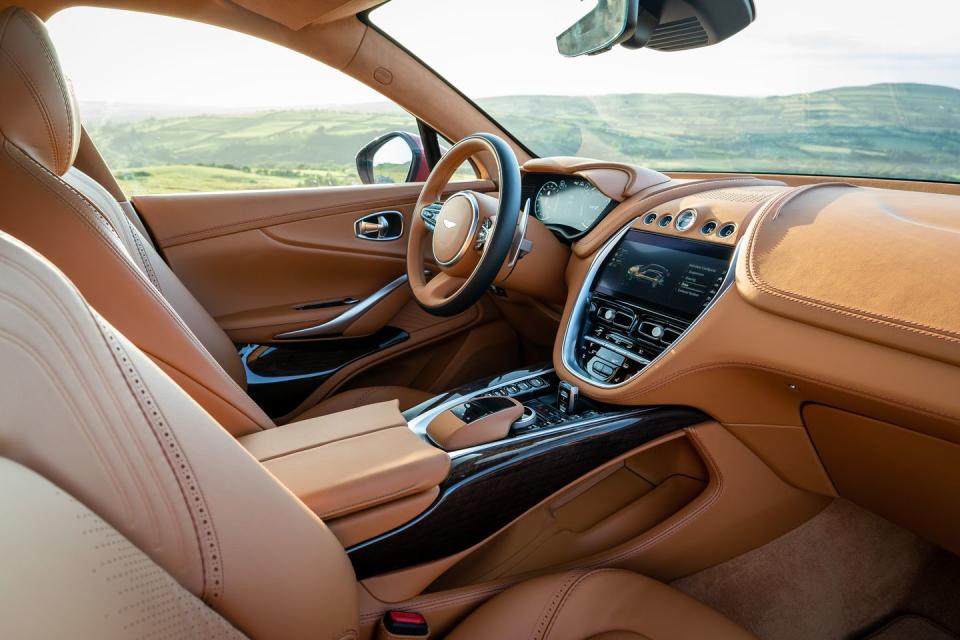2021 Aston Martin DBX Shines When Driven Hard

Much has changed since we sampled a prototype version of Aston Martin's new SUV, the DBX. Since that January drive, Aston has been hitting iceberg after iceberg, knocked down by both a pandemic-induced production shutdown and a cash crisis that threatened to bankrupt it. Aston lost $300 million during the first six months of the year, and its stock price has now fallen by more than 90 percent since the company went public back in 2018. CEO Andy Palmer is gone and his replacement, Tobias Moers, formerly of AMG, is joining a company in desperate need of good news.
Here's some: The now-production-ready DBX is as good to drive as our limited time in the prototype had us hoping it would be. The huge cost of developing its first SUV might have nearly broken Aston, but in terms of the way the car looks and drives, it seems it might have been entirely worth it.
Aston's new CEO will be familiar with the AMG-sourced twin-turbo 4.0-liter V-8, but the engine surprisingly doesn't make the DBX's highlight reel. The combination of the DBX's near 5000-pound curb weight and the engine's relatively modest 542 horsepower—61 fewer horses that you'd find in a Mercedes-AMG GLE63 S—means it is actually one of the slowest vehicles to use this twin-turbo V-8. But the engine still provides AMG levels of sound and fury when unleashed. The nine-speed automatic transmission uses a conventional torque converter rather than the wet clutch pack AMG employs in some applications. Gearchanges are both smooth and rapid. Brakes are strong, and pedal feel is excellent.

The DBX's best dynamic features are its standard air springs, its active anti-roll system, and an all-wheel-drive system that incorporates a limited-slip rear axle. These systems work seamlessly to effectively disguise the car's mass and to deliver a markedly different driving experience in each of the car's dynamic modes.
The default GT setting is predictably soft-edged, with active anti-roll bars not being too overactive and still allowing for some body lean under hard cornering. In GT mode, the DBX exhibits mild understeer as the Pirellis run short on adhesion. Switching to Sport sharpens responses, reduces body roll, and gives a much more rear-drive sensation to the power delivery. Sport Plus, which partly deactivates the stability control, turns the DBX into a two-and-a-half-ton hooligan, firming up the suspension even further and allowing the rear end to slide in a remarkably predictable and unthreatening fashion for something so tall and heavy.

The air springs' ability to vary ride height also gives the DBX a surprising amount of off-road prowess. Clearance is increased by up to two inches in the loftiest Terrain Plus mode, allowing the DBX to pass over modest obstacles without scraping noises. All-wheel drive and brake-based descent control allow it to scramble up and down slippery gradients without drama. It can also tow, another first for Aston, with the company claiming it can tug up to 5940 pounds.
While drifting and off-roading the DBX is good fun, the real test begins when we take it on a 300-mile tour of some of England's best roads. The drive, you will not be surprised to hear, is conducted in traditional British rain. The V-8 actually impresses more when asked to do less, its effortless muscularity and keen low-rev response is well suited for relaxed cruising. Refinement is good, markedly better than in Aston's traditional sports cars, and although the DBX's cabin lacks the sepulchral hush of something like a Rolls-Royce Cullinan or Mercedes GLS in the softest GT setting, the air springs allow for a compliant ride.

Even in its most relaxed mode, chassis discipline is never lacking. Once onto the lonely and demanding roads that cross the bleak emptiness of the Exmoor National Park, the DBX shows remarkable body control over rollercoaster dips and compressions, the gentle springing perfectly matched by the no-nonsense adaptive dampers. In its GT mode the DBX never feels wayward, and in Sport it doesn't feel harsh, the suspension refusing to be caught out by anything we could find to throw at it. Traction was impressive and the steering accurate enough to keep the DBX on a chosen line at speeds we are sure none of the company's sports cars could have matched over such tough terrain. Enthusiastic progress did carry a penalty, with fuel economy of just 12.6 mpg over 340 miles, with more than 200 of those at an 80-mph highway cruise.
The DBX is handsome, without any use of the "for an SUV" provisos commonly dropped in this part of the market. We looked long and hard for a bad angle and struggled to find one, with a possible asterisk over the sheer size of the toothy radiator grille. The styling team deftly integrated cues from the brand's lower and sleeker sports cars without making the DBX look like a pastiche. They have also made full use of the proportional freedom given by the car's platform and bonded aluminum underpinnings: It is shorter than the Lamborghini Urus and Bentley Bentayga, but sits on a longer wheelbase than either.

The cabin is similarly Aston with a twist. Many details are familiar, from the arrowhead door releases and the brand's curious tradition of sticking gear selection buttons on the dashboard like a 1950s Chrysler to the preponderance of Mercedes switchgear that comes with the DBX's Daimler-Bosch electrical architecture. The DBX's steering wheel marks a welcome return to circularity when compared to the squared-off wheels of DB11 and Vantage, but with a similarly thick rim and well-weighted metal gearchange paddles. It is roomy in the front, and the long wheelbase yields space in the back. It has the biggest cabin of any Aston since the wedge-shaped Lagonda sedan of the 1970s and '80s.
But although fit and finish felt good, as you would expect from a vehicle with a base price near $200,000, the level of technology is disappointing. Digital instruments are standard, a first for Aston, but the 10.2-inch screen in the center of the dashboard isn't touch sensitive, being based on the last-generation Mercedes infotainment system. Commands need to be made through a click-and-scroll controller. Five years ago, we wouldn't have complained. Today it feels dated.

Other notable omissions include the full suite of active safety systems and piloted cruise control, which are fast becoming luxury-car staples. The DBX can maintain distance and warn when it is leaving a lane but won't actively steer itself. The seat frames are carried over from the DB11, and we could only find comfort with a position that was lower and more reclined than we would normally pick in an SUV.
The DBX is not going to be confused with the brand's sports cars, but it is a deeply engaging machine shaped like a utility vehicle. Think of it an Aston Martin that happens to be an SUV rather than an SUV dressed up as an Aston. It's short on the latest tech toys and the overt showiness of others in the segment, but for those wealthy buyers in search of a luxury SUV they can actually enjoy driving hard, it deserves to be at the top of the list.
You Might Also Like

 Yahoo News
Yahoo News 